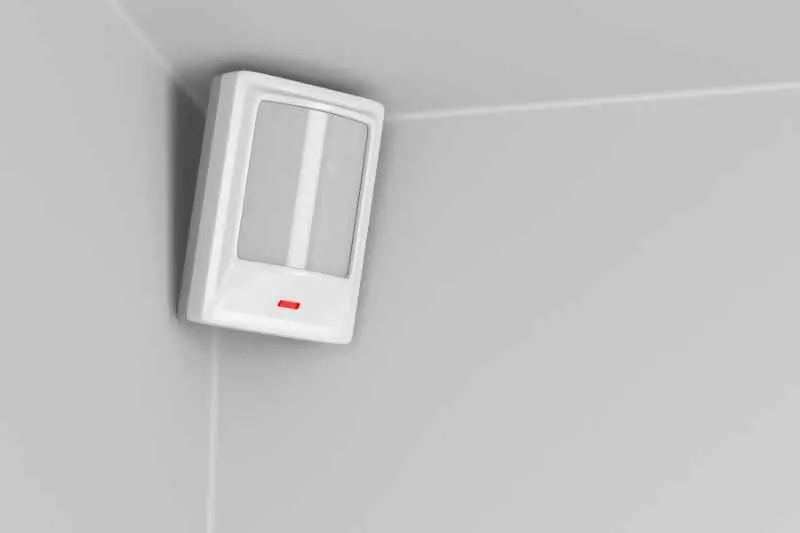Key takeaways
- IR sensors are used as a form of motion sensor for property protection.
- Infrared sensors detect changes in heat waves from moving objects before triggering a reaction (such as an alarm or lightbulb turning on).
- Infrared sensors come in two different types: active and passive.
- One of the best-infrared sensors to buy is the Ecolink Z-wave.

There is a lot to consider when it comes to improving your building security features. From fire alarms to access control systems, there’s a lot to worry about. One security tool that you shouldn’t overlook are IR sensors. These are especially useful in regard to protecting your property from intruders.
In this post, we’ll go over what IR sensors are. Next, we’ll discuss how they work and the different types. Finally, we’ll go over the advantages and disadvantages of infrared sensors.
This post covers:
- What is an IR sensor used for?
- How do IR sensors work?
- What are the different types of sensors in IR?
- Advantages and disadvantages of IR sensors
- The best infrared sensor to buy
What is an IR sensor used for?
An IR sensor is a type of motion detector that is used as a physical security measure to detect intruders on your property. Infrared sensors are a popular type of security alarm system. Depending on the use cases of a property, they can be used in both commercial and residential properties.
So, what’s a common use case for an IR sensor? Often, IR sensors are employed when a department store closes for the day.
For example, the closing manager will turn the IR sensor on. Then, if somebody breaks into the department store after hours, the infrared sensor will detect their movement and set off an alarm. What’s more, depending on the company that provides the sensor, the alarm system can be linked to emergency services such as the police.
Further, IR sensors can also be linked to motion sensor lights. This use case can also have an environmental impact. To illustrate, lights that turn on and off when somebody is in a room or hallway in a public space can save a ton of energy.
Motion sensor lights can also be used as a security tool. Lights that turn on when they detect motion on your property at night can deter intruders. Further, motion sensor lights can also provide energy-efficient lighting for possibly unsafe areas such as parking lots or dumpsters. And studies have shown time and again that a well-lit area can deter criminals from acting.
How do IR sensors work?
IR sensors use infrared light to detect heat signatures. All objects and people give off an infrared temperature. Infrared sensors are programmed to react when they detect a change in a heat signature.
For example, infrared sensors in motion sensor alarms detect heat signatures in humans and animals and set off an alarm.
The amount of coverage an infrared sensor provides depends on the device. Indoor and outdoor sensors will have a wider range of detectability.
Watch how ButterflyMX works:
What are the different types of sensors in IR?
There are only two types of sensors when it comes to infrared technology.
These are:
- Active infrared sensors. Active sensors commonly feature a single infrared light that shines across a space. So, if anything crosses this line of infrared light, the receiver detects this and triggers an alarm. These types of sensors can be handy when placed over a single, narrow entry point such as a doorway or window. However, they’re more commonly used for purposes unrelated to security technology. For example, a Roomba house cleaning vacuum will have infrared sensors that keep it from colliding with walls and other objects.
- Passive infrared sensors. Passive sensors cover a wider range than active sensors and are more commonly used in motion sensor lights and alarms, making them a great addition to your security system. They feature pyroelectric sensors that measure the disparity between space when something new enters it. So, when a high enough heat signature is registered by the pyroelectric sensors, an alarm will trigger.
Can IR sensors detect cars?
Yes, an IR sensor can detect a car. Infrared sensors are motion sensors, after all.
As a result, they can even detect an unmanned car or vehicle, such as a drone or remote control car. This is because they detect any change in heat signature across their field of view. In some cases, even insects can set off an infrared sensor.
IR sensor temperature ranges
While infrared sensors detect heat (which then triggers an alert) the actual temperature has a wide range. This is because every sensor is built differently. Typically, we’ve found that the average infrared sensor will detect heat in a range of -40 to 1000 degrees Celsius.

Advantages and disadvantages of IR sensors
The advantages of IR sensors are:
- They operate during the day and night.
- Sensors consume low electricity.
- Most sensors are weather resistant.
- They detect all motion in a certain range (even to a fault).
The disadvantages of IR sensors are:
- Dust, rain, snow, and other weather-related phenomena can trigger sensors.
- The range of the device is limited.
- Devices need to be paired with a camera so you can tell who or what triggered them.
The best-infrared sensor to buy
One of the best infrared sensors on the market is the Ecolink Z-wave
One of the standout features of the Ecolink Z-wave is its claim to be pet immune. This means that pets won’t set off the motion detector. A single unit costs $39.99 on Amazon, where the sensor has over 300 five-star ratings.
This device has a maximum range of 500 feet. So, depending on how large your property is, you might want more than one. Additionally, this system appears to integrate well with a smart home hub and centralized operating system for your property. This means that you can likely control it from a single app on your mobile phone.
Whether you choose the Ecolink Z-wave or a similar infrared motion sensor, security system integration should be a standout feature. Your infrared sensor can only do so much for your property. Consider pairing it with security devices such as access control systems and security cameras.







